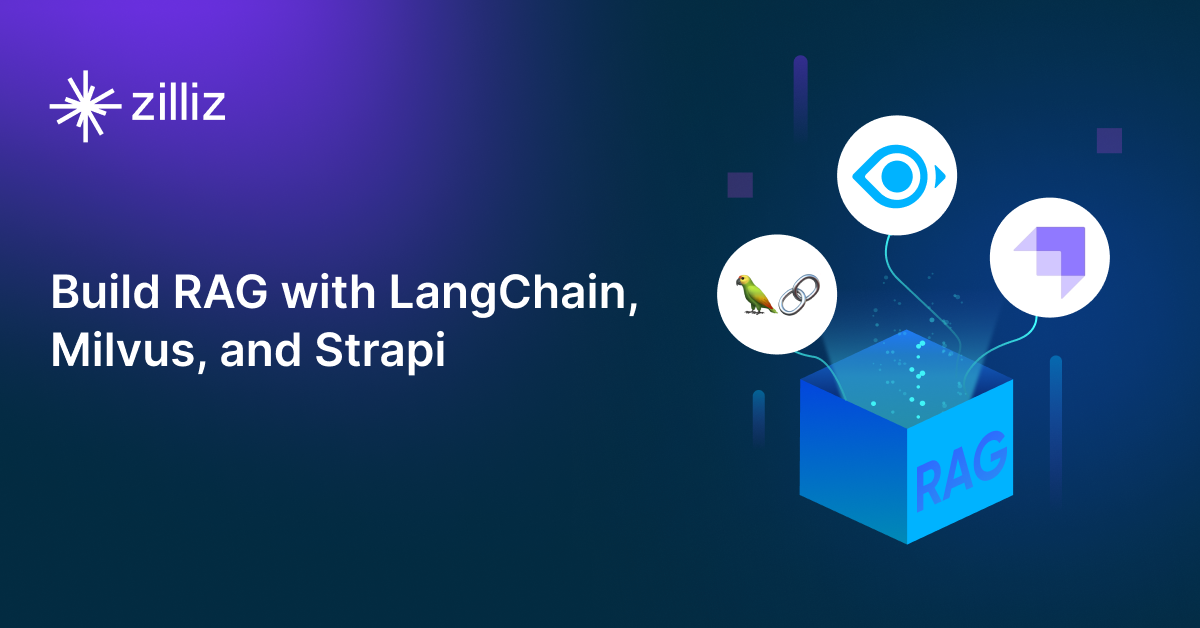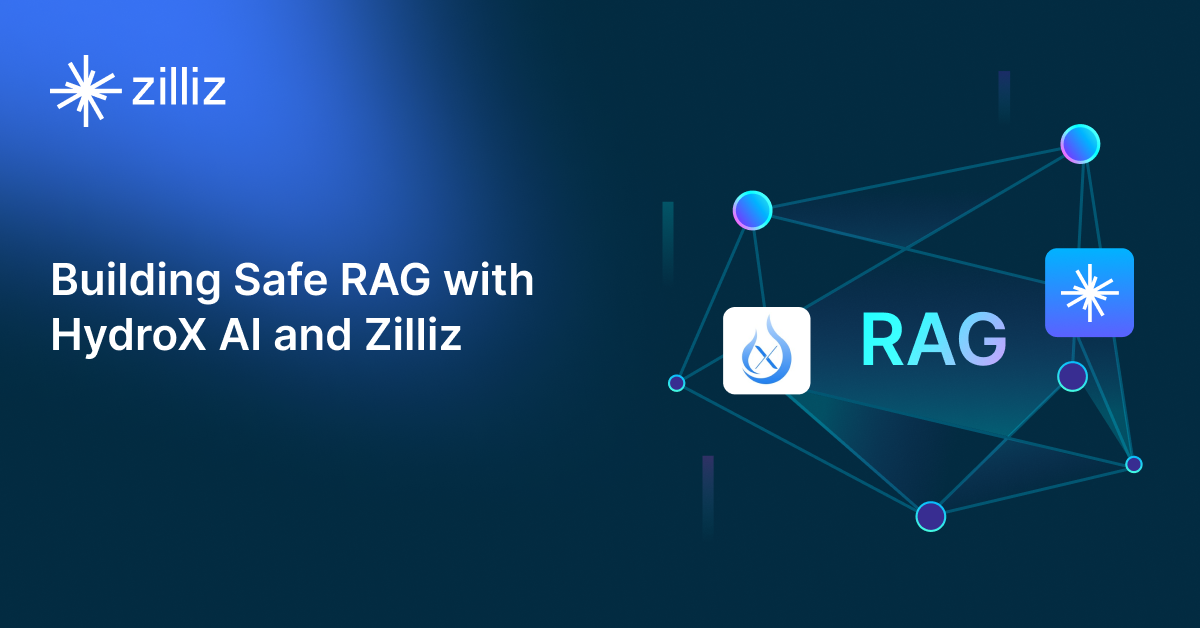Build RAG Chatbot with LangChain, OpenSearch, Anthropic Claude 3.5 Haiku, and IBM granite-embedding-278m-multilingual
Introduction to RAG
Retrieval-Augmented Generation (RAG) is a game-changer for GenAI applications, especially in conversational AI. It combines the power of pre-trained large language models (LLMs) like OpenAI’s GPT with external knowledge sources stored in vector databases such as Milvus and Zilliz Cloud, allowing for more accurate, contextually relevant, and up-to-date response generation. A RAG pipeline usually consists of four basic components: a vector database, an embedding model, an LLM, and a framework.
Key Components We'll Use for This RAG Chatbot
This tutorial shows you how to build a simple RAG chatbot in Python using the following components:
- LangChain: An open-source framework that helps you orchestrate the interaction between LLMs, vector stores, embedding models, etc, making it easier to integrate a RAG pipeline.
- OpenSearch: An open-source search and analytics suite derived from Elasticsearch. It offers robust full-text search and real-time analytics, with vector search available as an add-on for similarity-based queries, extending its capabilities to handle high-dimensional data. Since it is just a vector search add-on rather than a purpose-built vector database, it lacks scalability and availability and many other advanced features required by enterprise-level applications. Therefore, if you prefer a much more scalable solution or hate to manage your own infrastructure, we recommend using Zilliz Cloud, which is a fully managed vector database service built on the open-source Milvus and offers a free tier supporting up to 1 million vectors.)
- Anthropic Claude 3.5 Haiku: This model builds upon Claude 3's capabilities with enhanced understanding and generation of nuanced language. It excels in creative writing, conversational AI, and complex query handling. Best suited for tasks where clarity and depth of response are paramount, Claude 3.5 balances efficiency with sophisticated insights.
- IBM granite-embedding-278m-multilingual: This advanced AI model specializes in generating multilingual text embeddings, making it highly effective for tasks such as cross-linguistic information retrieval and translation. With its strength in understanding diverse languages, it excels in applications involving global datasets and multilingual customer engagement.
By the end of this tutorial, you’ll have a functional chatbot capable of answering questions based on a custom knowledge base.
Note: Since we may use proprietary models in our tutorials, make sure you have the required API key beforehand.
Step 1: Install and Set Up LangChain
%pip install --quiet --upgrade langchain-text-splitters langchain-community langgraph
Step 2: Install and Set Up Anthropic Claude 3.5 Haiku
pip install -qU "langchain[anthropic]"
import getpass
import os
if not os.environ.get("ANTHROPIC_API_KEY"):
os.environ["ANTHROPIC_API_KEY"] = getpass.getpass("Enter API key for Anthropic: ")
from langchain.chat_models import init_chat_model
llm = init_chat_model("claude-3-5-haiku-latest", model_provider="anthropic")
Step 3: Install and Set Up IBM granite-embedding-278m-multilingual
pip install -qU langchain-ibm
import getpass
import os
if not os.environ.get("WATSONX_APIKEY"):
os.environ["WATSONX_APIKEY"] = getpass.getpass("Enter API key for IBM watsonx: ")
from langchain_ibm import WatsonxEmbeddings
embeddings = WatsonxEmbeddings(
model_id="ibm/granite-embedding-278m-multilingual",
url="https://us-south.ml.cloud.ibm.com",
project_id="<WATSONX PROJECT_ID>",
)
Step 4: Install and Set Up OpenSearch
pip install --upgrade --quiet opensearch-py langchain-community
from langchain_community.vectorstores import OpenSearchVectorSearch
opensearch_vector_search = OpenSearchVectorSearch(
"http://localhost:9200",
"embeddings",
embedding_function
)
Step 5: Build a RAG Chatbot
Now that you’ve set up all components, let’s start to build a simple chatbot. We’ll use the Milvus introduction doc as a private knowledge base. You can replace it with your own dataset to customize your RAG chatbot.
import bs4
from langchain import hub
from langchain_community.document_loaders import WebBaseLoader
from langchain_core.documents import Document
from langchain_text_splitters import RecursiveCharacterTextSplitter
from langgraph.graph import START, StateGraph
from typing_extensions import List, TypedDict
# Load and chunk contents of the blog
loader = WebBaseLoader(
web_paths=("https://milvus.io/docs/overview.md",),
bs_kwargs=dict(
parse_only=bs4.SoupStrainer(
class_=("doc-style doc-post-content")
)
),
)
docs = loader.load()
text_splitter = RecursiveCharacterTextSplitter(chunk_size=1000, chunk_overlap=200)
all_splits = text_splitter.split_documents(docs)
# Index chunks
_ = vector_store.add_documents(documents=all_splits)
# Define prompt for question-answering
prompt = hub.pull("rlm/rag-prompt")
# Define state for application
class State(TypedDict):
question: str
context: List[Document]
answer: str
# Define application steps
def retrieve(state: State):
retrieved_docs = vector_store.similarity_search(state["question"])
return {"context": retrieved_docs}
def generate(state: State):
docs_content = "\n\n".join(doc.page_content for doc in state["context"])
messages = prompt.invoke({"question": state["question"], "context": docs_content})
response = llm.invoke(messages)
return {"answer": response.content}
# Compile application and test
graph_builder = StateGraph(State).add_sequence([retrieve, generate])
graph_builder.add_edge(START, "retrieve")
graph = graph_builder.compile()
Test the Chatbot
Yeah! You've built your own chatbot. Let's ask the chatbot a question.
response = graph.invoke({"question": "What data types does Milvus support?"})
print(response["answer"])
Example Output
Milvus supports various data types including sparse vectors, binary vectors, JSON, and arrays. Additionally, it handles common numerical and character types, making it versatile for different data modeling needs. This allows users to manage unstructured or multi-modal data efficiently.
Optimization Tips
As you build your RAG system, optimization is key to ensuring peak performance and efficiency. While setting up the components is an essential first step, fine-tuning each one will help you create a solution that works even better and scales seamlessly. In this section, we’ll share some practical tips for optimizing all these components, giving you the edge to build smarter, faster, and more responsive RAG applications.
LangChain optimization tips
To optimize LangChain, focus on minimizing redundant operations in your workflow by structuring your chains and agents efficiently. Use caching to avoid repeated computations, speeding up your system, and experiment with modular design to ensure that components like models or databases can be easily swapped out. This will provide both flexibility and efficiency, allowing you to quickly scale your system without unnecessary delays or complications.
OpenSearch optimization tips
To optimize OpenSearch in a Retrieval-Augmented Generation (RAG) setup, fine-tune indexing by enabling efficient mappings and reducing unnecessary stored fields. Use HNSW for vector search to speed up similarity queries while balancing recall and latency with appropriate ef_search and ef_construction values. Leverage shard and replica settings to distribute load effectively, and enable caching for frequent queries. Optimize text-based retrieval with BM25 tuning and custom analyzers for better relevance. Regularly monitor cluster health, index size, and query performance using OpenSearch Dashboards and adjust configurations accordingly.
Anthropic Claude 3.5 Haiku optimization tips
Claude 3.5 Haiku offers improved efficiency and accuracy over its predecessor, making it ideal for latency-sensitive RAG workflows. Optimize by leveraging structured prompts that minimize token waste while maintaining clarity. Use adaptive retrieval strategies where simpler queries receive fewer context documents, preventing excessive computation. Implement embeddings-based reranking to ensure only the most relevant information is passed to the model, improving both speed and response quality. Reduce API calls by caching high-traffic queries and employing response summarization techniques to streamline outputs. Tune temperature and nucleus sampling to ensure responses remain factual and well-structured, typically keeping temperature around 0.1-0.2 for strict accuracy. Optimize batch processing for large-scale retrieval tasks, reducing the overhead of multiple individual queries. Use Claude 3.5 Haiku in combination with higher-end models strategically, allowing for cost-effective scaling in production RAG systems.
IBM granite-embedding-278m-multilingual optimization tips
To optimize the IBM granite-embedding-278m-multilingual for your Retrieval-Augmented Generation (RAG) setup, consider fine-tuning the model on domain-specific data relevant to your use case, which helps improve accuracy in embeddings. Use mini-batches when processing queries to balance memory efficiency and speed, ensuring you leverage GPU acceleration. Implement a caching mechanism for frequently accessed documents to reduce retrieval latency, and experiment with different similarity metrics to find the most effective one for your data. Regularly monitor the performance and iterate over hyperparameters such as learning rates and embedding dimensions to further enhance your retrieval capabilities.
By implementing these tips across your components, you'll be able to enhance the performance and functionality of your RAG system, ensuring it’s optimized for both speed and accuracy. Keep testing, iterating, and refining your setup to stay ahead in the ever-evolving world of AI development.
RAG Cost Calculator: A Free Tool to Calculate Your Cost in Seconds
Estimating the cost of a Retrieval-Augmented Generation (RAG) pipeline involves analyzing expenses across vector storage, compute resources, and API usage. Key cost drivers include vector database queries, embedding generation, and LLM inference.
RAG Cost Calculator is a free tool that quickly estimates the cost of building a RAG pipeline, including chunking, embedding, vector storage/search, and LLM generation. It also helps you identify cost-saving opportunities and achieve up to 10x cost reduction on vector databases with the serverless option.
 Calculate your RAG cost
Calculate your RAG cost
What Have You Learned?
By diving into this tutorial, you’ve unlocked the magic of combining cutting-edge tools to build a powerful RAG system from scratch! You learned how LangChain acts as the ultimate orchestrator, seamlessly connecting your pipeline’s components while handling workflows like document loading, chunking, and context-aware prompting. OpenSearch stepped in as your trusty vector database, storing and retrieving embeddings at lightning speed—like a treasure chest that knows exactly where to find the gems you need. Then came Anthropic’s Claude 3.5 Haiku, the LLM superstar, turning retrieved context into human-like responses with flair, balancing speed and accuracy like a pro. And let’s not forget the IBM granite-embedding-278m-multilingual model, your multilingual embedding wizard, transforming text into rich numerical representations that capture meaning across languages. Together, these tools form a dynamic RAG pipeline that’s smarter, faster, and ready to tackle real-world queries!
But wait—there’s more! You also picked up pro tips for optimizing performance, like tweaking chunk sizes for better retrieval and adjusting temperature settings to control response creativity. The free RAG cost calculator you explored? That’s your secret weapon for balancing budget and efficiency as you scale. Now you’re equipped to build systems that don’t just answer questions but understand context, adapt to multilingual inputs, and deliver value. So what’s next? Grab your keyboard and start experimenting! Tweak parameters, test edge cases, and watch your RAG app come alive. The future of AI-powered search and conversation is yours to shape—go build something bold, innovative, and uniquely you. The tools are ready. The possibilities are endless. Let’s make magic happen! 🚀
Further Resources
🌟 In addition to this RAG tutorial, unleash your full potential with these incredible resources to level up your RAG skills.
- How to Build a Multimodal RAG | Documentation
- How to Enhance the Performance of Your RAG Pipeline
- Graph RAG with Milvus | Documentation
- How to Evaluate RAG Applications - Zilliz Learn
- Generative AI Resource Hub | Zilliz
We'd Love to Hear What You Think!
We’d love to hear your thoughts! 🌟 Leave your questions or comments below or join our vibrant Milvus Discord community to share your experiences, ask questions, or connect with thousands of AI enthusiasts. Your journey matters to us!
If you like this tutorial, show your support by giving our Milvus GitHub repo a star ⭐—it means the world to us and inspires us to keep creating! 💖
- Introduction to RAG
- Key Components We'll Use for This RAG Chatbot
- Step 1: Install and Set Up LangChain
- Step 2: Install and Set Up Anthropic Claude 3.5 Haiku
- Step 3: Install and Set Up IBM granite-embedding-278m-multilingual
- Step 4: Install and Set Up OpenSearch
- Step 5: Build a RAG Chatbot
- Optimization Tips
- RAG Cost Calculator: A Free Tool to Calculate Your Cost in Seconds
- What Have You Learned?
- Further Resources
- We'd Love to Hear What You Think!
Content
Vector Database at Scale
Zilliz Cloud is a fully-managed vector database built for scale, perfect for your RAG apps.
Try Zilliz Cloud for Free


